10 MIN READ
Late-Season Soybean Management
July 23, 2018
- As the season winds down, growers should continue scouting fields, especially later-planted fields that will remain green well into late summer.
- Keeping a soybean crop healthy, even late in the season (R3 or later), is important for maximizing yield potential.
- Reducing insect, disease, and weed pressure, nitrogen deficiency, and drought stress during the critical soybean reproductive growth stages can help prevent potential yield loss.
- Proper disease and insect identification is a critical management step.
Insects (1,2,3)
Soybean aphids
Soybean aphids are a major insect pest in Midwest soybean fields. Aphids are small (1/16th inch long), pear-shaped insects that range from pale yellow to lime green in color. Adults have distinct black cornicles (tail pipes). Although they feed on leaves, stems, and pods, they are most often found on the underside of leaves. Heavy infestations can result in the stunting of plant growth and development, which can reduce yield potential and transmit virus diseases.
Late-season management of soybean aphids can be challenging. If feeding continues through the pod filling stage, pod set may be affected, and plants may produce fewer seeds per pod. As much as 50% yield reductions may occur in severely infested fields. However, aphid populations that are over the treatment threshold when pods are being filled can have a greater effect on yield potential than outbreaks at the R5 or R6 growth stages.
The occurrence of aphids is highly variable each season. Late planted fields are usually more susceptible to later season infestations; scouting these fields first is advised. To sample for soybean aphid, select a representative number of plants, 20 to 30, throughout the area that is being scouted. Count the aphids on each plant and determine the average number of aphids per plant. The economic threshold for plants at or before the R5 stage is an average of 250 aphids per plant, more than 80% of the plants having aphids, and an aphid population that is increasing. If all three of these factors are true, an insecticide treatment is recommended. Another scouting method, speed scouting, can also be used. With this method, for each 50-acre area of soybean, initially inspect 11 plants and keep a record of the numbers of infested and un-infested plants. From those results, the grower can decide whether or not to treat the field or to inspect five additional plants. If a treatment decision cannot be made after a maximum of 31 plants have been inspected, resample in three to four days. The decision to treat is still based on the 250 aphids per plant threshold but does offer a faster method to assess the need for treatment. A speed sampling worksheet can be obtained at this link: https://www.ent.iastate.edu/soybeanresearch/files/page/files/2009_speed_scouting_blank_form.pdf
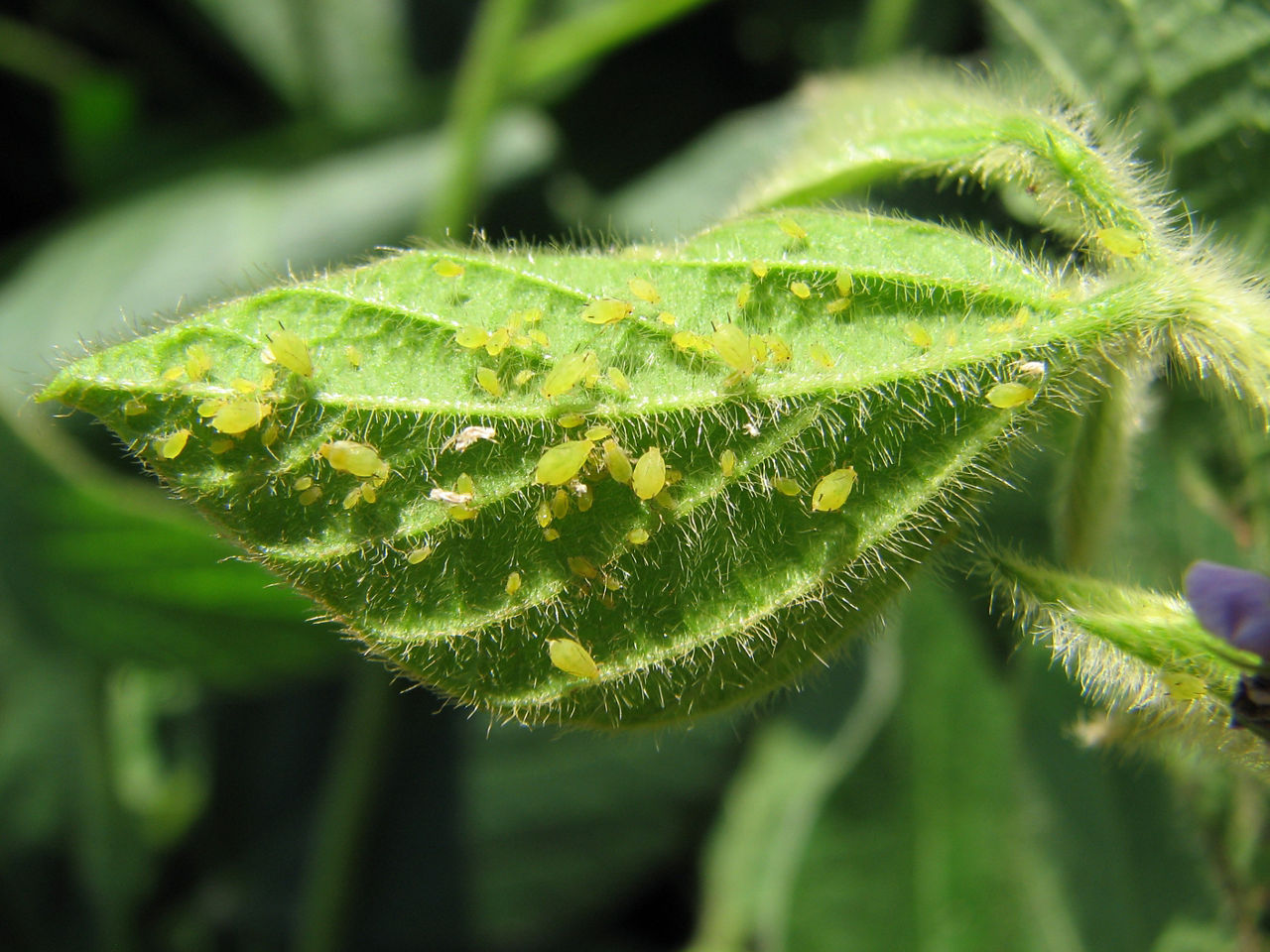
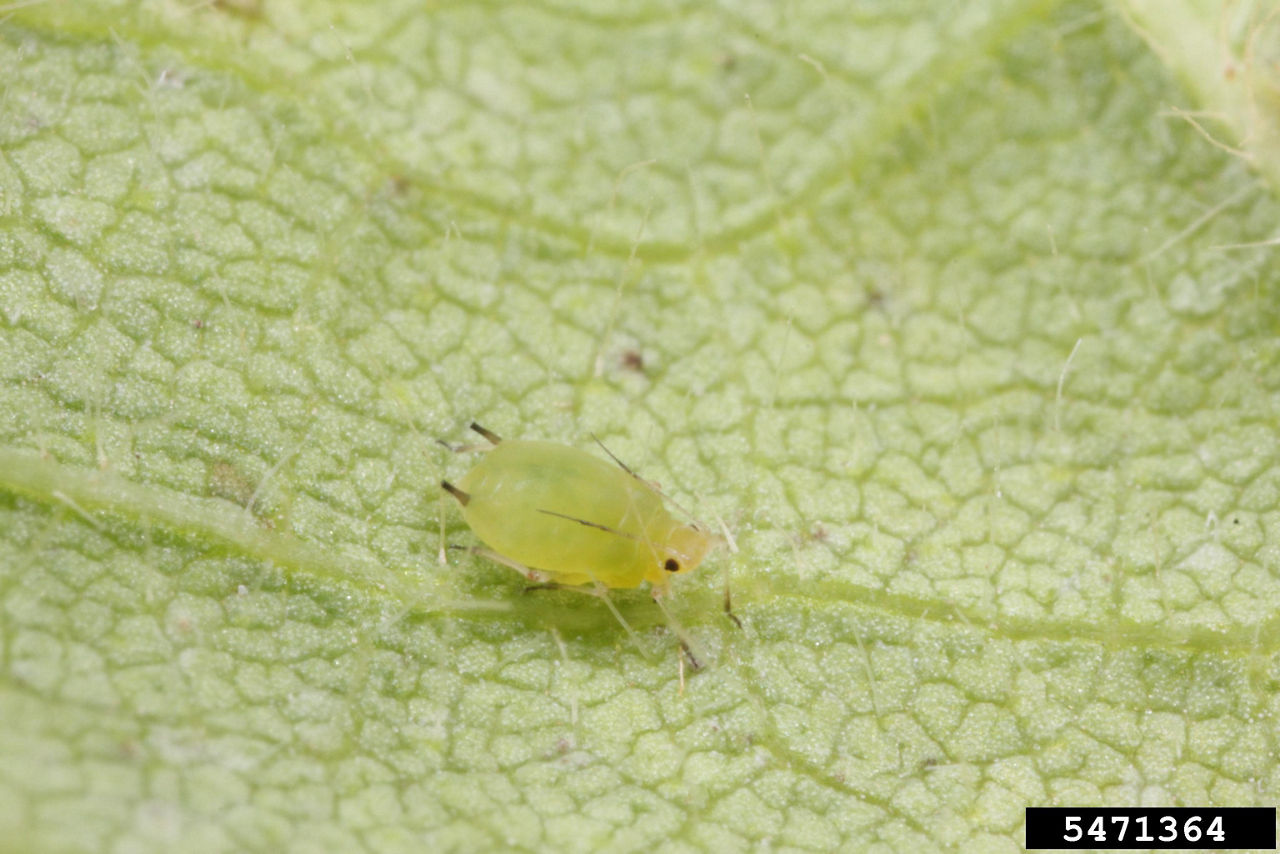
Stink bugs
The species of the stink bug most commonly found in soybean fields are green stink bug, red shouldered stink bug, brown stink bug (Figure 3), and brown marmorated stink bug.
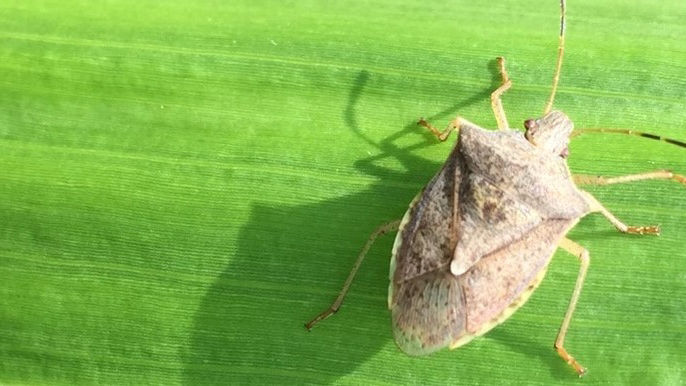
Stink bugs are shield shaped. The nymphs look like adults in shape but not always coloration and are wingless. Both adults and nymphs can cause injury to soybeans. The injury from stink bugs is caused when they insert their piercing– sucking mouthparts into the plant and extract juices. Damage is greatest when they feed on the seed in the developing pod. Feeding can cause pods to drop. Stink bug injury on soybean pods is not apparent; therefore, the injury threshold for stink bugs is based on numbers of adults and nymphs (immatures).
Sample by walking into the field at least 100 ft from the field’s edge, as numbers tend to be higher on the edges and do not represent the population within the whole field. A sweep net can be used to take 3 to 5 sets of 10 sweeps at different locations. Combine the numbers of both adults and nymphs. Insecticide treatments should be considered when an average of 4 or more adults and/or nymphs of all species are collected per 10 sweeps in commodity soybeans. When grown for seed or food grade soybeans, the threshold should be lowered to only 2 adults and/or nymphs per sample.
Sampling the brown marmorated stink bug using a sweep net is difficult, so count them by walking slowly through the soybean planting. Insecticide treatments should be considered for brown marmorated stinkbug when an average of 1-2 nymphs and adults per row foot is reached through at least the R4 stage.
Second generation bean leaf beetle
Second generation bean leaf beetles feed on the pods and seeds of the plant, causing direct damage to the harvestable part of the soybean. Treatment to prevent pod damage from bean leaf beetle is based on the level of insect injury observed on the pods.

To determine if economic damage is occurring, select 10 random plants from around the field, and examine all the pods on each plant. Record the number of total pods and the number of pods exhibiting injury. Calculate the percent pod injury based on the 10 plants. Treatment is only recommended when the percent pod injury approaches 10-15% and beetles are still present. Beetles will start to leave the field as beans mature, so it is important to confirm that they are still there. A series of sweeps with the sweep net is a good way to determine if adults are still present in the field.
Diseases 4
Pod set through seed fill stages (R3 through R6) are the most critical period for yield potential, and leaf loss can significantly reduce yield potential. Frogeye leaf spot, sudden death syndrome, stem canker, phytophthora root rot, charcoal rot, pod and stem blight, brown stem rot, and white mold are fungal diseases that may affect soybean plants late in the season.
Frogeye leaf spot produces spots on the leaves (Figure 5), while interveinal yellowing may form with sudden death syndrome (SDS) (Figure 6), BSR, and stem canker. Premature defoliation is also a concern with frogeye leaf spot, SDS and BSR.
Signs and symptoms of pod and stem blight (PSB) can be found on stems, petioles, and pods in the late reproductive stages as irregularly shaped brown blotches with small black specks. Infection on pods may result in fewer or smaller seeds per pod. Leaf defoliation is also an issue if infestation is severe.
Symptoms of stem canker first appear during the early reproductive stages as small, red-brown lesions (Figure 7). Initial lesions are usually found near a lower leaf node and expand lengthwise as the season progresses. In northern stem canker lesions eventually girdle the stem, causing wilting and plant death, while southern stem canker does not cause the stem girdling.
Cercospora (Figure 8) and frog eye leaf spot are the most common diseases managed by foliar fungicide sprays. White mold (Figure 9) may be suppressed by fungicide applications that are applied earlier in the season. Cankers, PBS, charcoal rot (Figure 10) and SDS cannot be managed with foliar fungicides. Keeping a soybean crop healthy, even late in the season, is important for maximizing yield potential.
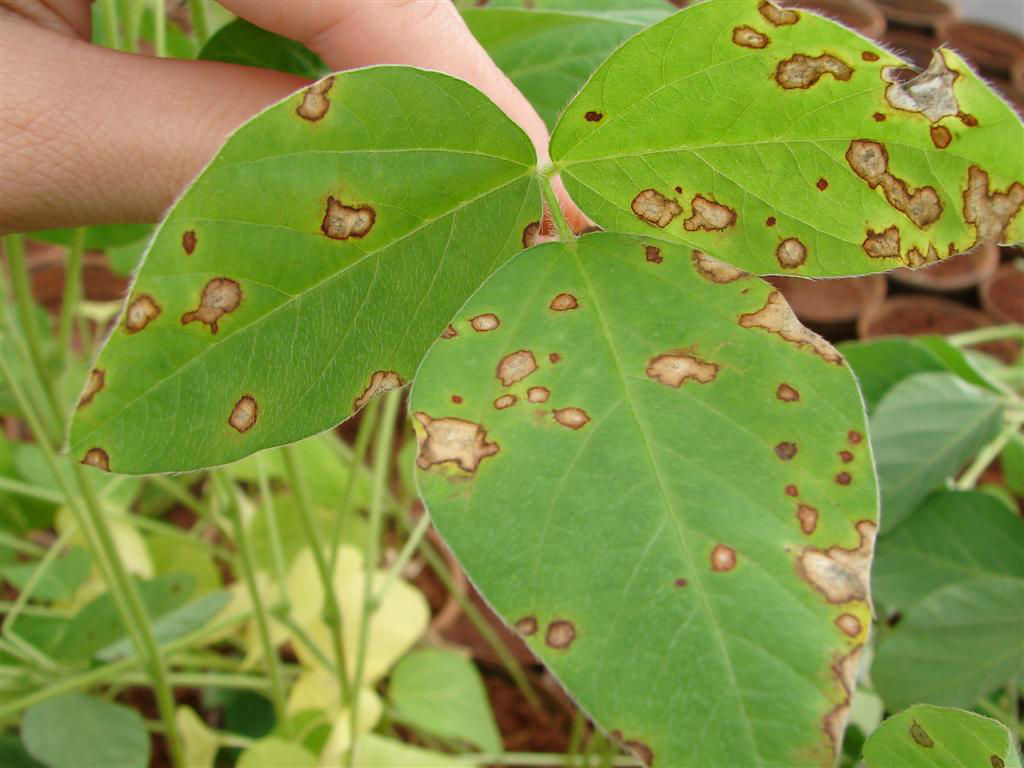
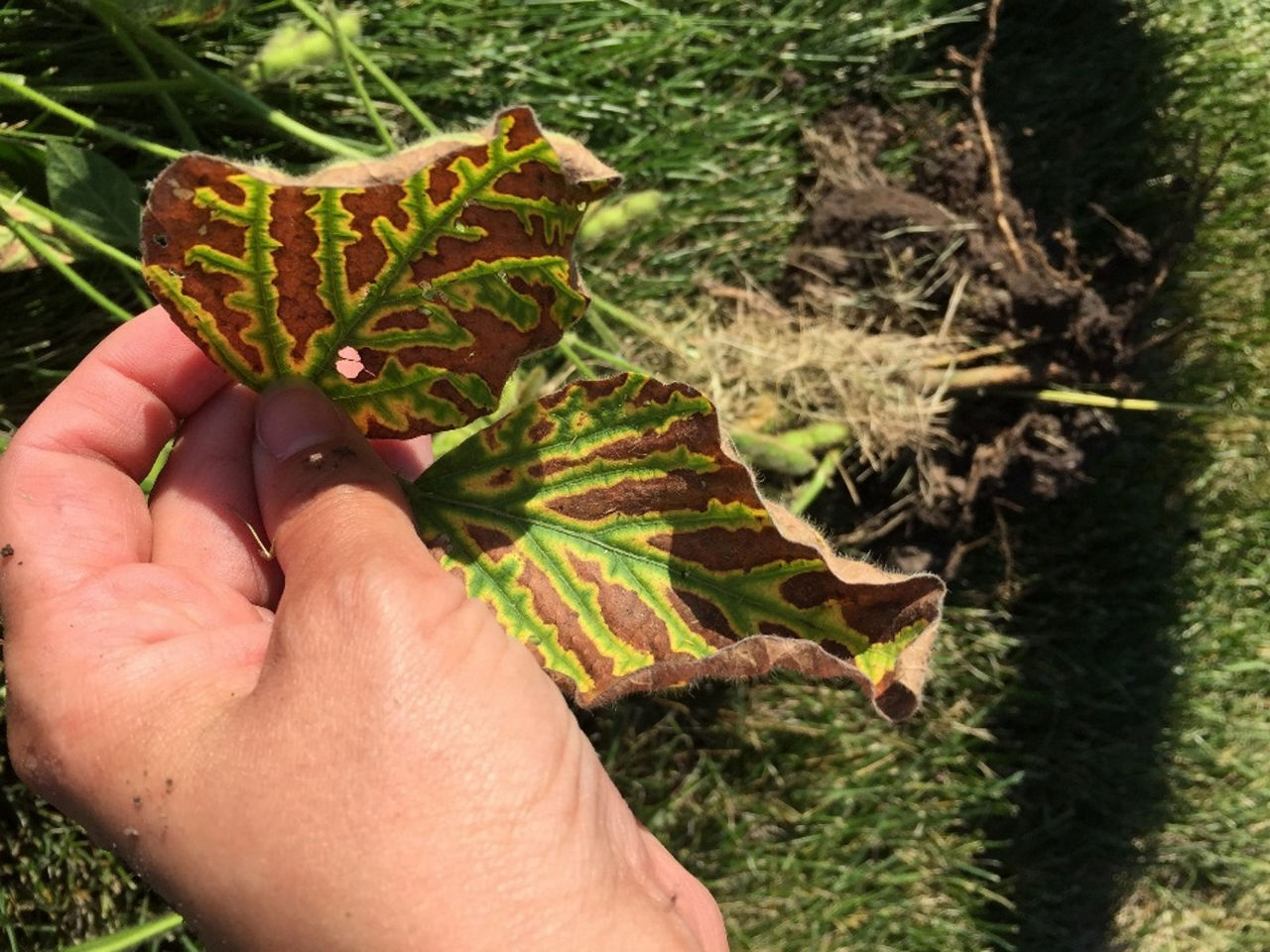
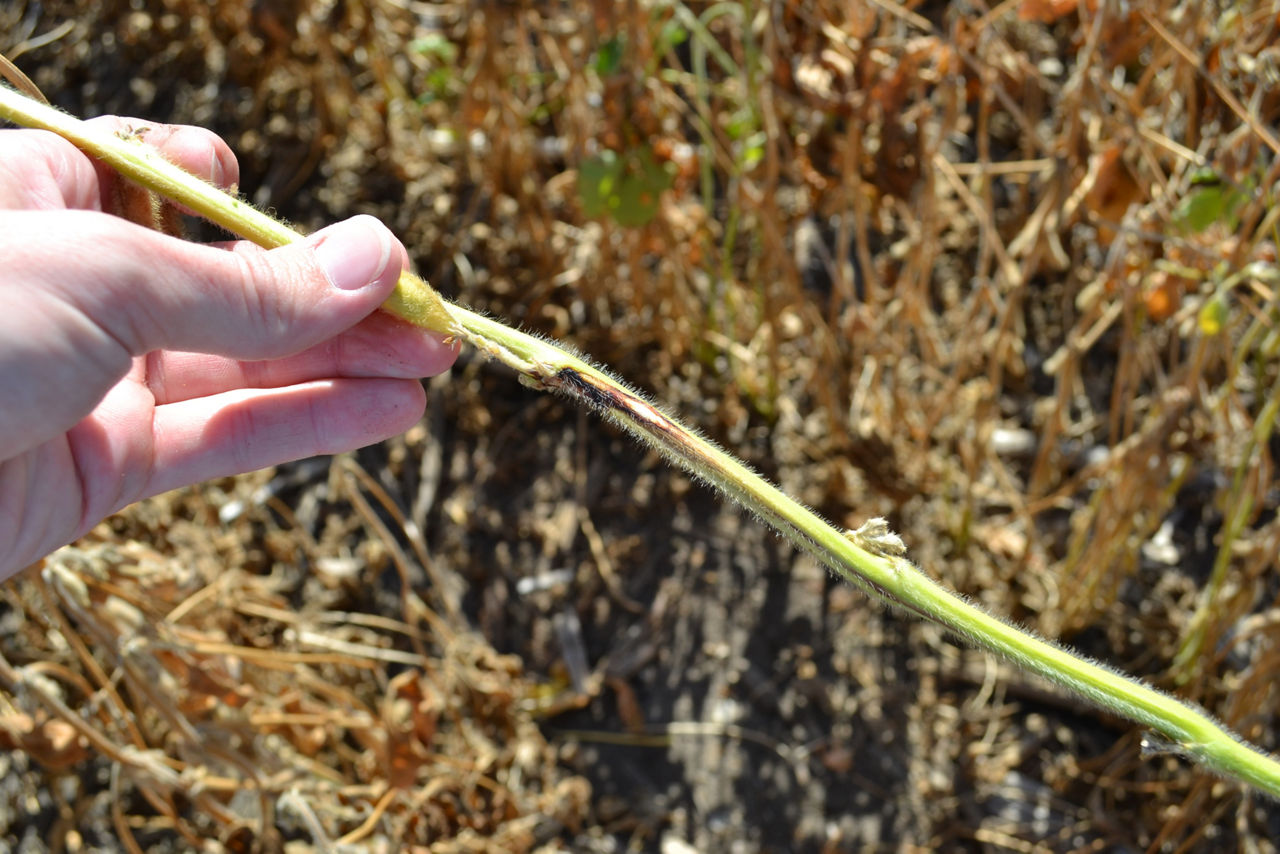
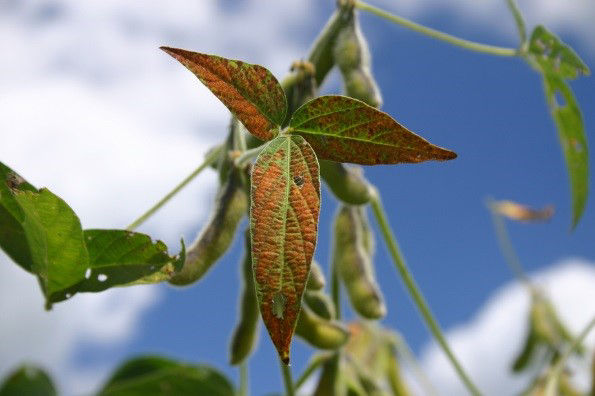
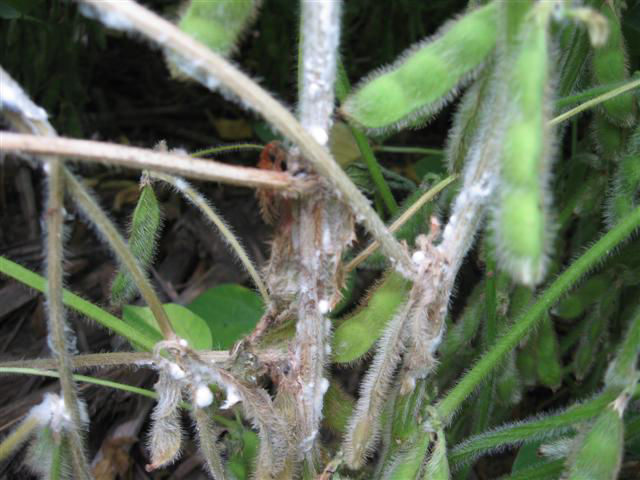
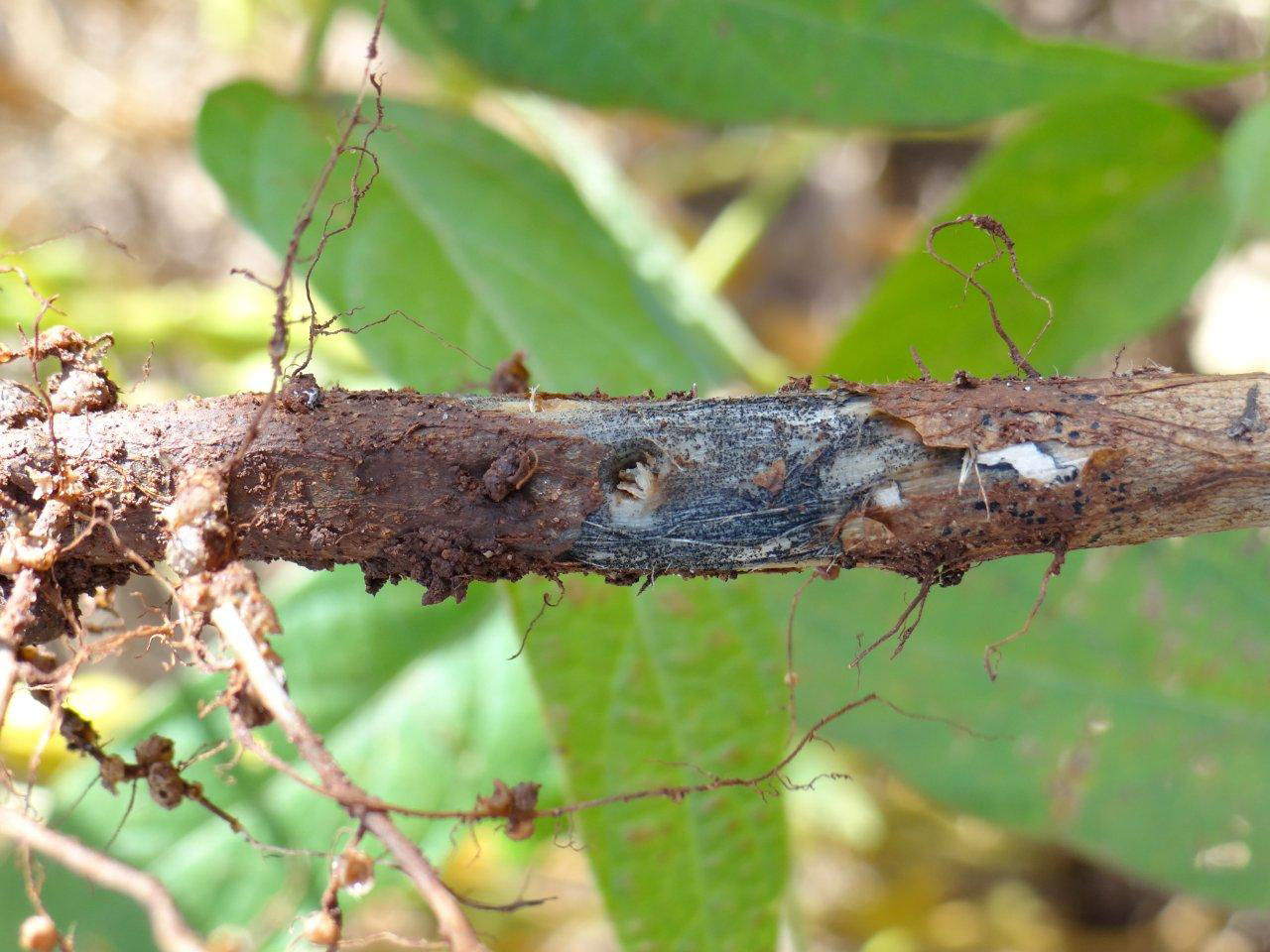
Tips for Proper Fungicide Application. 5
Soybean diseases often start in the lower canopy and move into the middle, then upper canopy as the crop matures. Therefore, fungicide applications need to be placed as deep into the canopy as possible. Sprayer reconfiguration is necessary to obtain good coverage and canopy penetration. Using a spray volume of at least 15 gallons per acre is important to provide good coverage, especially later in the season when the canopy is deeper and denser. Nozzle type, spray pressure, application volume, and speed will determine the uniformity of spray deposition and penetration into the canopy. Flat-fan pattern nozzles are generally the best choice, provided the spray from these nozzles is characterized as high-fine to mid-medium (200-to-300-micron droplets in diameter). Proper nozzle orientation and overlap is also critical to achieve optimum spray deposition. Timing application is also critical, many studies have shown applications at the R3 stage provide the best results in the presence of leaf disease pressure.
Weed Management 6
Weeds compete with the crop for light, moisture, and nutrients and can be a yield-limiting factor. To help increase yield potential, weeds must be controlled between the V1 and V3 soybean stages. This is usually referred to as the critical time for weed control. Early season weed control is important for early canopy development and helping to maximize soybean yield. Plants that develop canopies early may have an increase in flowering time and number of main-stem nodes.
Weeds that emerge later in the season have little direct effect on yield potential but may interfere with harvesting and add foreign matter to the harvested crop (Figure 11). Although good early-season weed control is critical for optimum yield potential, sometimes situations arise where in-season weed management is warranted. Over-the-top applications can be used to help control late-germinating weeds and weeds not controlled by preplant or preemergence herbicides. If an herbicide application is necessary, choose the chemistry depending upon the type of weed(s) present in the field keeping in mind any harvest date restrictions. While late season weeds will most likely not impact the current crop yield, they can contribute to the seed banks causing issues in the next growing season. Hand removal may be the only viable option to remove the late emerging weeds.
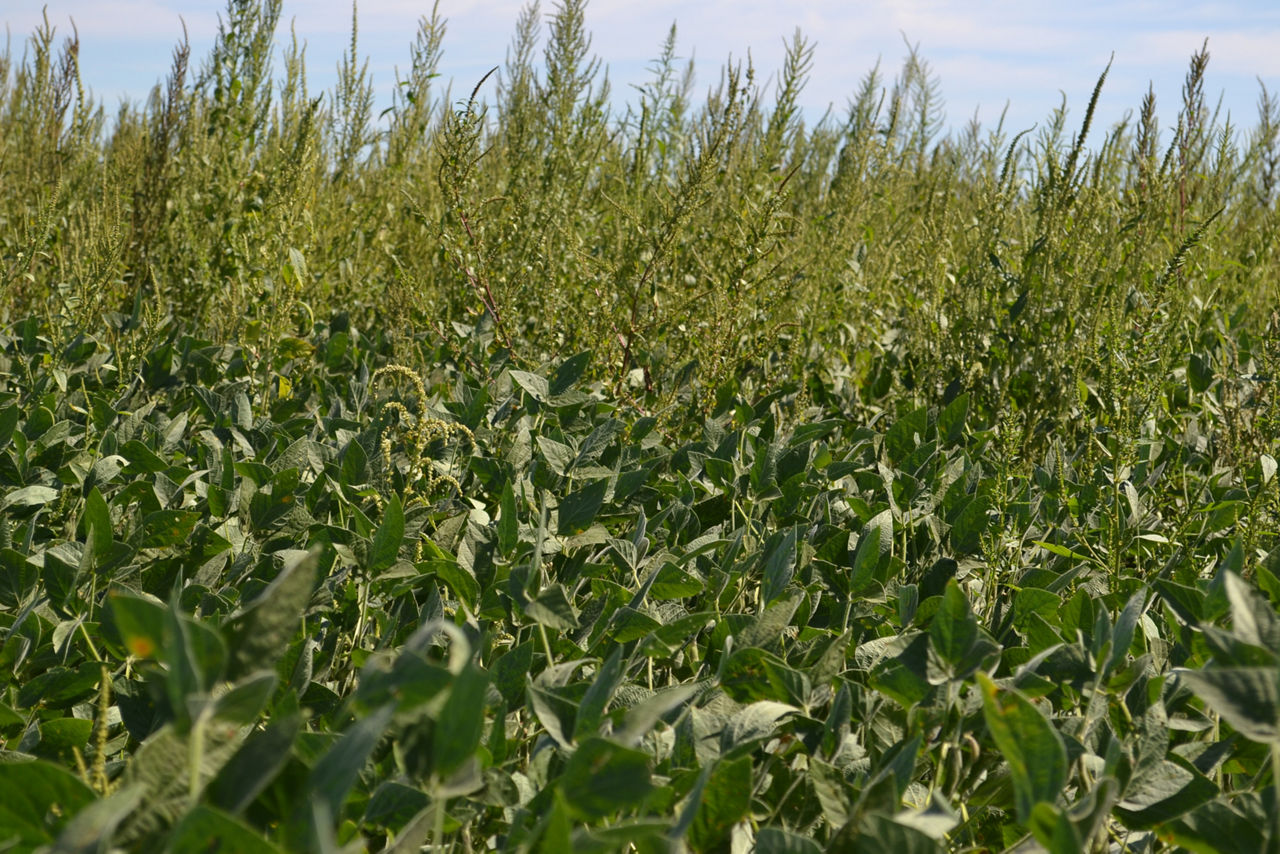
Water Stress 7
Water demand is highest for soybean plants during pod development (R3 to R4) and seed fill (R5 to R6). Moisture stress from flowering through the pod fill stage can severely reduce yield potential by causing the production of smaller and/or fewer seeds. Late-season irrigation is recommended to provide adequate soil moisture to help promote maximum seed weight.
Nitrogen Application 8
Evaluating the need for additional Nitrogen (N) applications to soybean has been difficult for two reasons. Because soybeans absorb 60% of the N after R3, it is difficult to ensure that adequate N is available when it is needed by the crop. However, the application of N fertilizer in soybean usually results in a decrease in N fixation. Thus, when applying additional N, the plant may reduce the amount of N fixed, so the amount of N from the fertilizer equals the amount that may have been fixed. These two reasons explain why yield response to additional N has been small and inconsistent. A recent study in Nebraska allowed researchers to summarize the results as follows:
- The nitrogen supply from mineralization and fixation do not fully satisfy soybean’s N requirement, especially under high yield scenarios.
- Yield response to large N fertilizer amounts is modest and depends on the yield level (5 bu/acre at 50 bu/acre yield level, but 13 bu/acre at 90 bu/acre yield level).
- Seed protein concentration increases with additional N fertilizer.
- If N applications in soybean are being considered, priority should be given to fields with a history of consistently high yields.
Scouting soybean fields late in the season can help identify problems that may be controlled through targeted management strategies and may offer insights for the next growing season. Look for insect damage, weed escapes, and signs of diseases. Late-emerging weeds can cause harvest losses and increase moisture and trash content at harvest. Fields should be monitored for pod-feeding insects through R7 growth stage. Late-season irrigation is recommended to have adequate soil moisture to ensure maximum seed weight. A fungicide application is warranted when disease incidence reaches threshold levels.
Sources:
1 Tilmon, K.J., Hodgson, E.W., O’Neil, M.E., Ragsdale, D.W., 2011. Biology of the soybean aphid, Aphid glycines (in the United States). Journal of Integrated Pest Management, Vol 2, No. 2
2 Koch, R. and Potter, B. 2018. Scouting for soybean aphid. https://extension.umn.edu/soybean-pest-management/scouting-soybean-aphid#whole-plant-counts-1353560
3 Soybean insect pests. Dr. Dominic Reisig, North Carolina Cooperative Extension Service. http://ipm.ncsu.edu.
4 Late season soybean diseases. Laura Sweets, 2013. University of Missouri Extension. https://ipm.missouri.edu/.
5 Dorrance, A., Draper, M.A., and Hershman, D.E. 2008. Using foliar fungicides to manage soybean rust. Plant Health Initiative. NCERA publication SR-2008
6 Ferrell, J.A., MacDonald, G.E., and Leon, R. 2012. Weed management in soybean. University of Florida, SS-AGR-05. http://edis.ifas.ufl.edu.
7 Thomas J. G. and Blaine, B., 2010. Soybean irrigation, Mississippi State University Extension, publication number 2185. http://msucares.com.
8 Cafaro La Menza, N. , Grassini, P., Specht, J., Rees, J., Timmerman, A., Whitney, T. and Glewen, K. 2018. Is soybean yield limited by Nitrogen supply? University of Nebraska. https://cropwatch.unl.edu/2018/soybean-yield-limited-nitrogen-supply#:~:text=Soybean%20has%20a%20large%20nitrogen,240%20lbs%20N%20per%20acre.
1310_59361
Seed Brands & Traits
Crop Protection
Disclaimer
Always read and follow pesticide label directions, insect resistance management requirements (where applicable), and grain marketing and all other stewardship practices.
©2024 Bayer Group. All rights reserved.